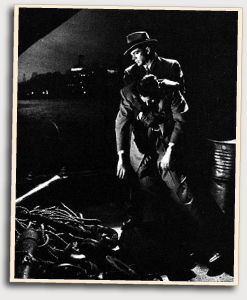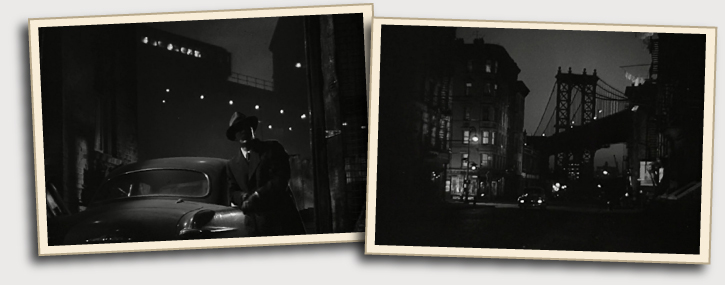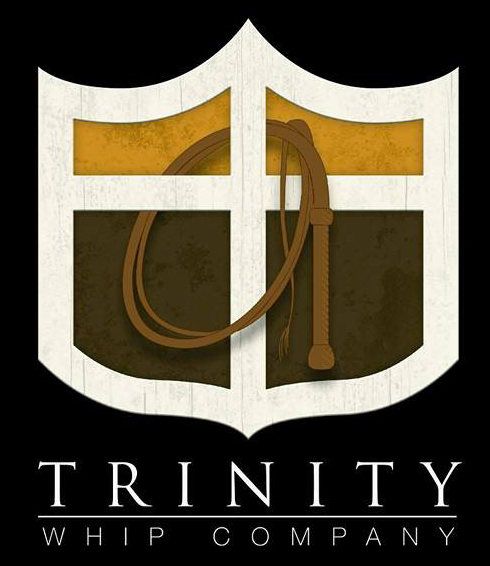"Where The Sidewalk Ends" (1950)
Reviewed by Eric Renderking Fisk - July 2010
I have no problem admitting that I’ve tried to write this review several different times and deleted every other attempt before starting this one. The only thing to survive are the few images that I’ve gathered during this time. This was after wondering if I should devote a whole section of The Chronicles to this motion picture, almost like a mini-site like I created for The Maltese Falcon. Doesn’t this motion picture that’s so important to the retrocentric and classic film community deserve more than just one article to review it?
And if there is going to be only one article about it on The Fedora Chronicles, it should be definitive. No pressure though… no pressure.
The reason why I’ve prolonged this struggle is due to the fact that it’s one of the most perfect Film Noir motion pictures. While The Maltese Falcon and Kiss Me Deadly are the book ends to that genre and its golden era; this motion picture epitomizes it. The Otto Preminger film is the epitome of this style of film and the black and white medium itself. When many people think the phrase “film noir” – our minds often pictures the images that this film evokes; men in fedoras, smoke filled and dimly lit rooms and dark city streets, tormented and flawed protagonists or anti-heroes.
Insp. Nicholas Foley: "Your job is to detect criminals, not to punish them."
During the first few scenes we learn through some brilliantly written exposition dialog that the hero of the story, Det. Mark Dixon, is a violent cop. Played by Dana Andrews and his gruff interior and intellectual and sentimental gooey center, Dixon is constantly in a lot of trouble for beating up cons and suspects. Dixon is told by his boss inspector Foley that under no certain terms that the next complaint will lead to his termination.
We further learn that there’s a reason why he has something to prove; Dixon’s old man was a con artist who was always getting into trouble with the law. Mark is out to prove that he’s nothing like his father.
While trying to prove his old rival Scalise (Gary Merrill) was involved in the murder that brought a swift end to a night of gambling in a make-shift hotel room, Dixon beats and accidently kills one of the witnesses and possible suspect Ken Paine (Craig Stevens). Dixon makes matters worse for himself by covering up the manslaughter which accidently implicates Paine’s former father-in-law as the murderer. Dixon complicates things when he sets out to prove his rival Scalise’s guilt of both killing in the hotel room and accidental Dixon himself committed. If things aren't complicated enough, Dixon falls in love with Paine’s ex-wife - Gene Tierney’s Morgan Taylor.
Dixon is eventually tossed off the case for being “too close” and for retaining a lawyer for Morgan’s father. I guess that's something you're not supposed to do when you're a police detective and your department thinks it's caught it's suspect for a crime. That sort of thing might play havoc with the grand jury process. Dixon spends the rest of the motion picture with his conflicted ideals between law and order, right and wrong, and then solves the case while implicating his own guilt in the accidental killing of Paine and cover-up. Viewers like myself aren’t sure whether to applaud Dixon’s final acts before the end of the film, or scream in frustration since he could have gotten away with everything if he just kept his mouth shut.
I hope I’m not giving away anything by saying that it’s debatable whether or not Dixon did the right thing in the end, or if it’s realistic to believe his new found girlfriend would actually remain in love with him knowing what kind of man and crooked cop he turned out to be.
Morgan Taylor: It's a wonderful day. No job. Everybody against me. My poor dad sitting in a cell... and it's a wonderful day. Isn't that amazing?
I might be in the minority when I say that this film is actually better than “Laura.” The acting in this film makes me believe that it’s actually more believable regardless of the fact that there are aspects of this fim that might be (believe it or not) more implausible then the aforementioned.
 Most
of the men in this film are true masculine types. There’s not a single Lydecker
in this film that I can remember, every man of any significance in this
film is someone whom you can believe is capable of living in such a gritty,
hardnosed world. Those who aren’t are the obvious hustlers that get by with
their wits and the oily cons who weasel out by either being slick or flying
under the predators radar. The effeminate Clifton Webb types that manage
to pray on our modern civility are nowhere to be seen, in this world only
the tough or the obscure with their heads down can survive.
Most
of the men in this film are true masculine types. There’s not a single Lydecker
in this film that I can remember, every man of any significance in this
film is someone whom you can believe is capable of living in such a gritty,
hardnosed world. Those who aren’t are the obvious hustlers that get by with
their wits and the oily cons who weasel out by either being slick or flying
under the predators radar. The effeminate Clifton Webb types that manage
to pray on our modern civility are nowhere to be seen, in this world only
the tough or the obscure with their heads down can survive.
Ms. Tierney pays a much more believable roll in "Where The Side Walk
Ends" in comparison to "Laura." Her character still loves Dixon despite
being the man who almost accidently sent her father to jail for a crime
her dad couldn’t commit (but would love to have been the true culprit, regardless)
There’s a much deeper warmth to her then when she played the title role
in “Laura,” we can actually understand why Andrews’ “Dixon” could actually
fall for her. Perhaps Morgan loves Dixon because he's the kind of guy who
breaks some of the rules to preserve a higher ideal and morality. Whatever
the reason this divorced woman is playing for keeps, and in the context
of the era and the events that transpired, we get it even if we might not
understand it completely.
In yet another film, Otto Preminger can do no wrong. In these celluloid reels, he allows his actors to do their work and behave like real people would in this surreal situation. That technique brings audience members into the drama and for my first viewing I was caught up in the story and believed for a short while this was real.
The real star of this motion picture is the cinematography. As I said in the beginning of this rant, “Where The Sidewalk Ends” is one of the most pivotal pieces of the Film Noir genre. This has the quintessential use of shadow over light; this is one of the first films that I know of that spares no expense to use silhouettes for mood and atmosphere. The use of darkness tells the audience that the darkness of this world is as vast as it is consuming. Nothing in this film is ever too perfectly lit and some of the set pieces have the perfect use of grit and dirt to impose a real world “lived in” feel. Some of the outdoor scenes use of weather and different time of night to set the mood is iconic; I would venture to say that the vast majority of the images other retrocentric sites use as backdrops and wallpapers are in fact screen shots of this film.
The final word I have to say about “Where The Sidewalk Ends” is that this is also an essential film because of the use of costumes, mostly fedoras. Each of the characters either has a unique fedora that’s different from all the others in this film, or wears an average one in different ways. I’m not sure if it’s intentional or not, but it’s the perfect way for directors to say something about the characters and is a technique I wish more directors today would use. Short on flaws, high on perfection and it’s perfect execution of the “Film Noir” Concept...










